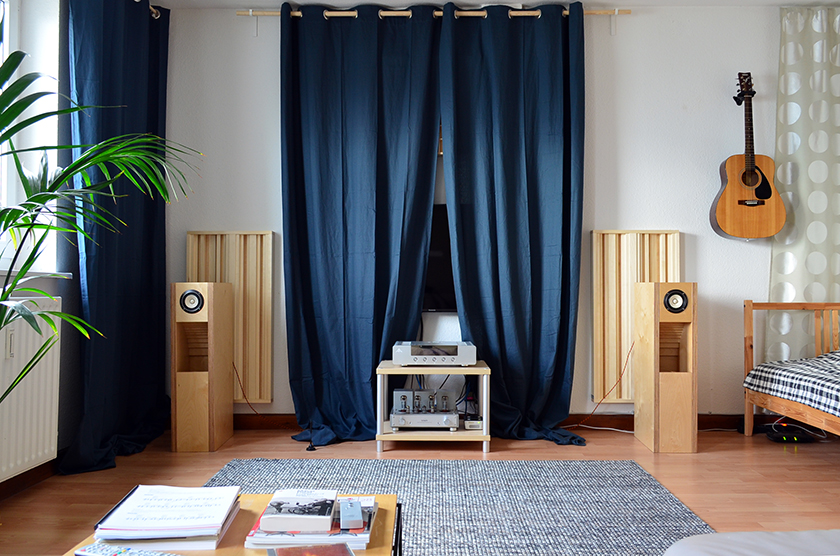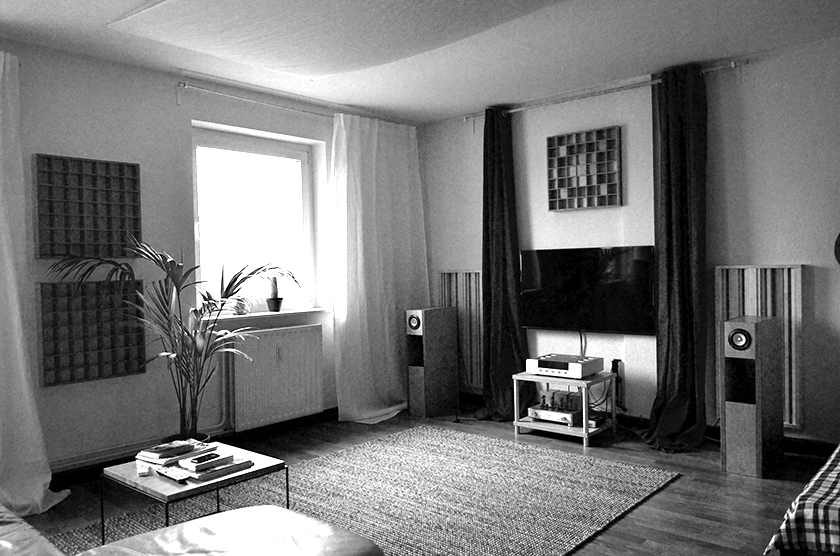I don’t mean to brag guys, don’t take me wrong, but the system really rocks these days and this is something I would like to report. I suspect the main reason for the outstanding performance lays nowhere else but in the improved room acoustic. As one can see on the images, there are several diffusers scattered around, also one sail is attached to the ceiling. Let me introduce you briefly to what I did recently in terms of room acoustic treatment.

You know when listening extensively to an audio system trying to asses and analyse its traits and virtues one reach some conclusions suggested by intuition, experience and rational analysis. So after a long listening the conclusion I reached was that the first sound reflection points behind the speakers and on the ceiling should be treated so that the reflected sound energy does not hit the ears so hard but being distributed evenly. So I ordered two big SC quadratic residue diffusers to put behind the speakers.
These are high quality products made out of furniture-grade plywood from the german company t.akustik — heavy and thick but working pretty well. I played around positioning them until I spot the location where their impact on the reproduced audio was most remarkable. What I can tell is that these two pieces of diffuser are doing really great job breaking down the sound waves and distributing acoustic energy so that the music feels more natural, the stage grows deeper, and the perception of the space somehow changes so that one feel himself sitting not in his own room but rather being there — in the performance venue.
I ordered also two square OG sound diffusers meant for mounting on the ceiling at the first reflection points. OG diffusers are aimed toward adding natural atmosphere feeling to rooms by uniformly scattering sound waves arriving from any direction. I fixed them there and they were working pretty well too, but I felt that only two of them are not enough. I mean the ceiling in my room is really low at around 2.5 meters from the ground and the early reflections from a top are slapping like a hammer. And these diffusers are damn heavy so it is not a good idea to fix a lot of them on a ceiling made of gypsum board. So I decided to try absorption instead of diffusion there.

So I did, I fixed a linen curtain from IKEA with thumb tacks to the ceiling. It was an easy endeavour that brought unexpected results. Linen IKEA curtain on the ceiling at the first reflection points did magic, it is unbelievable how chip trick like this could improve things which big investment could hardly do. The ceiling treatment contributed further for a relaxed and more natural listening experience affecting both tonal and sonic character of the reproduction.
Before the ceiling sail have been implemented the height of the soundstage was dramatically low, I mean the musicians were playing bellow the TV and this was pretty embarrassing and destroying a big part of the illusion. Absorbing these early ceiling reflections has turned out to be the key for achieving a natural soundstage height where the performers are placed in front instead of bellow the TV. I am very happy that this had happened because for me the sound space illusion and imaging are as important as tone color and timbral realism.
Next thing I did was to experiment with applying diffusion on the closest sidewall by which I hoped to improve the sound stage balance that the asymmetrical room setup usually tends to harm. Placing one square OG diffuser on the closest side wall where the sound of the right speaker is directly reflected brought a significant improvement by making the wall stepping few meters aback. Putting the next diffuser above the first one confirmed the effect.

The last CG diffuser was placed above the TV which brought some additional solidity to the soundstage presentation. When listening to music the curtains are pulled together covering TV and diffuser which brings better listening experience. But probably because the curtains are not so heavy the effect of the CG diffuser, in spite of being behind them, is still recognisable, madness.
So enough with diffusion and absorption guys, I am fed up with this topic, but just wanted to share my opinion that room treatment cannot be avoided if long term satisfactory listening experience has been sought after. Yes, the room had lost its virgin look and is far from innocent now, which is not cool in a way. I mean a short glimpse is enough to reveal its purpose to serve as an audio reproduction venue as well as a living space. Definitely not nice, but what should one do? Form follows function. I am agree that the primary function of the living room and its interior is to makes us feel comfortable and relaxed after work, but also it has to provide us with acoustic friendly environment that facilitate sound propagation in a natural way, without stressing certain frequencies and creating flatter echoes. Now, that’s really enough on that topic.

Beside the room treatment the next big thing that occurred recently is the upgrade of the speaker drivers. As I mentioned in a previous post the FE 108 Sigma were replaced with FE 108 Sol drivers which brought a significant improvement. Now 3 weeks after the replacement, I can assure you that mounting FE-108 Sol in BK-108 enclosure and disposing the former notch filters opened a new chapter in my audiophile journey. I mean I am now quite sure that this is one of the ways to reach audio nirvana — single driver speaker directly coupled to the amplifier. I am quite sure that a large part of the improvement I hear derive from the lack of any passive elements (notch filter or crossover) standing between the amplifier and speakers. The improvement in the time domain — transients speed and detail resolution is immense and something I can hardly believe one can attain when complex crossover networks have been utilised. Yesterday I stumbled upon an interesting article on the topic of speaker requirements for realism that confirmed my notion. The author examines the Crossover-Less Single-Driver approach as one of the options, here is a link to the article. In short I think I found my way, and I think also it is one of the most appropriate ways for modestly sized rooms and budgets.
The other positive thing that happened to the system recently was the introduction of Belden 8402 microphone cable interconnects I reported in my recent post. They blended very naturally into the ecosystem of my audio rig, levering the realism one level up.
Other change that took place is the replacement of the Jcat USB cable, used to connect streamer and processor, with Lindy USB 2.0 black. It might sound weird but in my system Lindy cable that costs 3.20 € completely outperformed Jcat that costs 320 €. Think about it – 100 times difference in price! How could that be? But it is so. I don’t want to say that Jcat is a bad choice and that’s why I am selling it, I just wan’t to tell you that in my current system configuration it does not make any sense. It sounds clinical and thin, in comparison Lindy is full bodied and revealing, it shows higher dynamic contrast, better separation and as a whole it is way more musical. I think this particular case is a matter of a synergy and proves the fact that good reviews and high price tags does not guarantee satisfactory results in the context of any system.
Currently the system sounds really good and I am living in a bliss guys, it is not a joke. But this does not mean I reached the final destination, don’t get me wrong. It is never ending this journey and that’s the cool thing about it. Further plans for pouring money into that project are already laid down. I would like to try the new hybrid power supply for SOtM sMS-200 streamer SOtM sPS-500 once it becomes available. I also think to try some low powered SET amplifier which might fit better with the speakers and bring me closer to the real sound.
That’s it for now fellows, thank you for stopping by.

